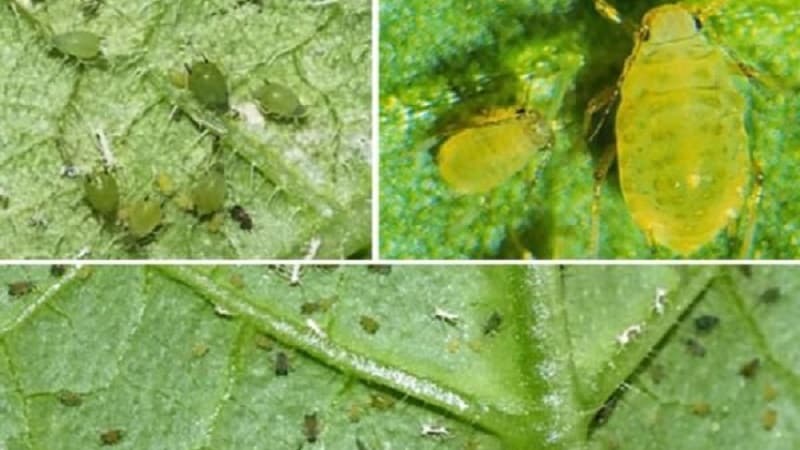How to treat cucumbers against aphids during fruiting?
Aphids can appear on cucumbers using any cultivation method. In open beds, infection occurs in July, in greenhouses - in spring. The pest is most often found in areas with a humid and warm climate. In such conditions, insects actively reproduce.
Folk remedies and biological products that are safe for plants and humans will help protect plantings during the period of active fruiting. In the article we will tell you about the signs and causes of damage, methods of getting rid of aphids and preventive measures.
Aphids and danger to cucumbers
The melon or cotton aphid (Aphis gossypii) is a representative of the genus Aphids, polyphagous and cosmopolitan. Distributed everywhere. The type of development is incompletely cyclical. Females do not require males to reproduce. Larvae and wingless adults go to winter. The generation of virgins consists of winged and wingless insects.
 In the spring they wake up and begin to actively reproduce, filling the space around them. The bugs feed on the sap of the leaves, which leads to complete depletion of the plants.
In the spring they wake up and begin to actively reproduce, filling the space around them. The bugs feed on the sap of the leaves, which leads to complete depletion of the plants.
Important! If you do not take measures to combat the pest, you may lose your harvest.
What aphid affects cucumbers?
Planting cucumbers in closed and open ground is affected by green and black color. The length of the bugs is 2-5 mm. The body is soft, covered with growths and hairs of varying lengths. The antennae are located on the forehead, and the organs of touch are located on them.
The oral apparatus is represented by a proboscis, with which the aphid bites through the plant tissue and sucks out the juice. The legs are long and thin, performing walking and jumping functions. On the abdomen there are juice tubes that secrete honeydew.
The insect adapts to any weather conditions. Asexual females reproduce at lightning speed. During the summer, they lay 50 eggs at a time.
Colonies accumulate on the upper leaves, the lower leaves are too dense for them. Therefore, superficial treatments are sufficient to kill insects. In spring, when the air warms up to +5 °C, aphids become active.
Reference. When drinking juice from leaves, aphids secrete a sticky coating, which leads to impaired photosynthesis and the development of a bacterial infection.
Signs
Signs of aphid infestation of cucumbers:
- delayed plant growth and flowering;
- the upper leaves wither, then dry and curl;
- honeydew appears on the greenery;
- hordes of ants in the area, attracted by honeydew;
- the ovaries fall off;
- the lower leaves wither;
- colonies of green or black insects appear on the back of the leaves.
Causes
The main cause of plant infestation is ants. They are attracted to the sweet honeydew on the leaves. Crawling from place to place, insects carry the larvae, infecting new bushes.
Violation of the rules of agricultural technology, thickening of plantings, lack of fresh air in the greenhouse, excessive nitrogen content in the soil contribute to the appearance of pests on the site.
Aphids have settled in dry weeds and unharvested plant debris since last season. At air temperatures above +5 °C, females move to young plantings and begin to lay eggs on the back of the leaves.
Methods of control during the fruiting period
How to get rid of aphids? Fighting it will require effort, especially when the number of insects is rapidly increasing. Modern insecticides and biological products are effective. Folk remedies based on herbs, soda, tobacco shag and ash can repel pests, but cannot completely destroy them. Infusions and decoctions are used during the period of active fruiting, when chemicals are prohibited.
Hand picking is a labor-intensive way to get rid of insects. It is used in case of minor damage to plantings.
At the same time, they are fighting ants. Anthills are filled with Anteater or boiling water, and the soil in the beds is constantly loosened to repel insects that do not tolerate interference in their life.
Marigolds, oregano, daisies, and cumin are planted next to cucumbers to attract ladybugs that feed on aphids.
Prevention
Preventive measures will help prevent infection of cucumber plantings:
- installation of mosquito nets in greenhouses;
- the use of covering material to protect bushes in open beds;
- fighting ants;
- frequent weeding, getting rid of weeds;
- disinfection of seeds in potassium permanganate or “Fitosporin” before sowing;
- soil treatment with copper sulfate;
- disinfection of greenhouses with sulfur bombs;
- alternating spray preparations so as not to cause addiction;
- compliance with crop rotation;
- cleaning of plant residues;
- regular feeding cucumbers with mineral and organic fertilizers.
Read also:
Aphids appeared on peppers in the greenhouse.
How and with what to treat garlic before planting for the winter.
Conclusion
An integrated approach to the destruction of aphids on cucumbers is the key to successful control. During the fruiting period, it is prohibited to use insecticides.Toxic substances accumulate in green mass and fruits. The use of such a product leads to general poisoning of the human body.
Alternating biological products and folk remedies, following the rules of agricultural technology, and destroying anthills will help preserve the harvest and get rid of the pest.
Folk remedies and biological products that are safe for plants and humans will help protect plantings during the period of active fruiting... MORE BOLTOLOGY HOW AND WHERE APHIDS COME FROM AND WHAT IT LOOKS LIKE.